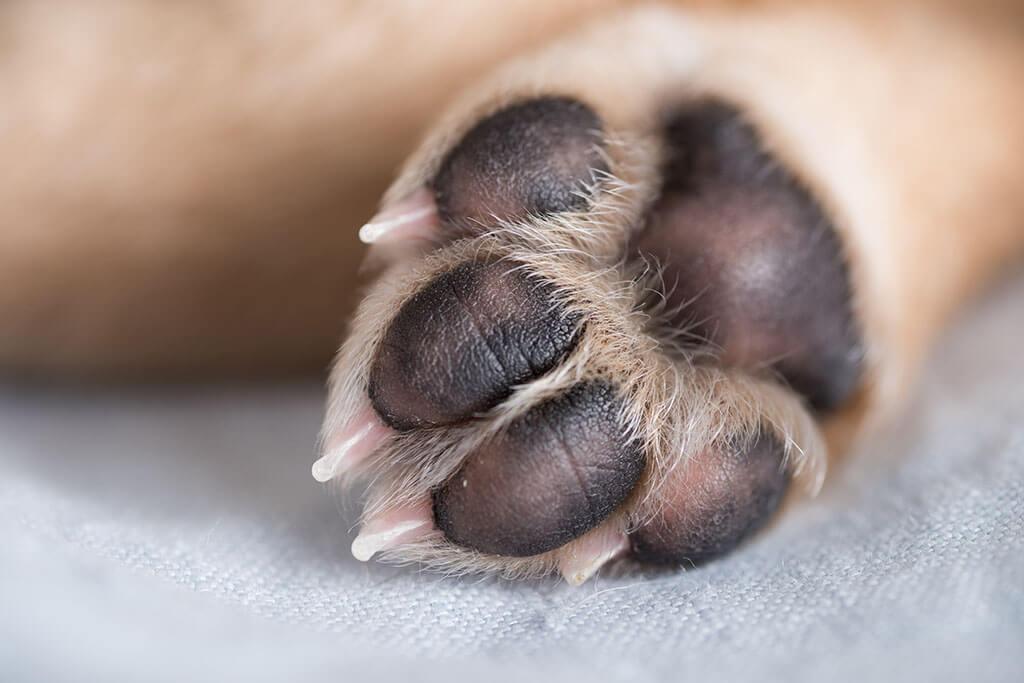Navigate the often-misunderstood realm of pododermatitis in dogs with our comprehensive guide, where we dissect everything from early symptoms to effective treatments. If your dog’s relentless licking or chewing keeps you awake, it’s time to address their discomfort.
Pododermatitis In Dogs: From Symptoms To Treatment

What is Pododermatitis in Dogs?
Pododermatitis is a term that describes the inflammation of the skin on the paw and can also include the paw pad and nails. It can occur secondary to a variety of causes and is usually treatable by a veterinarian, who will recommend treatment based on the underlying cause (diagnosis).
Key facts:
- Infectious causes of pododermatitis include bacteria, fungi, and parasites.
- Non-infectious causes of pododermatitis include immune-meditated disorders, endocrine diseases, neoplasia, and trauma.
- The diagnosis of the cause is based on the patient’s medical history, clinical signs, and diagnostic tests.
- Diagnostic tests include cytology, biopsy, trichogram, and culture of the affected area.
- Treatment of pododermatitis depends on the cause and could include local (medicated shampoo, cream, or ointment) or systemic medication (oral or injectable medicine) and supportive dietary supplementation.
- Pododermatitis can be primary or secondary.
Causes of Pododermatitis
Primary pododermatitis can occur due to diseases and conditions of the paw which we’ll describe later in this section. Secondary pododermatitis is the term veterinarians use when pododermatitis occurs due to itching or licking (most often) as a result of a primary problem. It’s also common for pododermatitis to be caused by a combination of factors.
Bacterial Infections
An imbalance of the microflora on the skin or the colonization of the skin by pathogenic bacteria can cause or contribute to pododermatitis in dogs.
It’s also important to note that dogs can suffer from secondary bacterial infections following damage to the skin caused by irritation, such as licking, and disruption of its normal microflora.
Parasitic Infections
Parasites affecting the skin, such as ticks, some protozoa, and worms can trigger itching and lead to pododermatitis.
Fungal Infections
An imbalance or colonization of the skin by fungi can cause dermatitis following itching and irritation of the skin. A common example of this is a yeast infection called Malassezia or dermatophytosis, commonly known as ringworm, such as Trichophyton. Malassezia is normally present in your dog’s skin and ears, but if numbers rise too much, it can cause a problem.
Endocrine Disease
Hormonal diseases can cause immunosuppression which can trigger pododermatitis. Examples of these include hypothyroidism and hyperadrenocorticism.
Immune-Mediated Disorders
Conditions such as allergies and atopy (for example environmental allergies) can lead to pododermatitis following irritation (which is a common manifestation of these conditions) due to excessive scratching and licking of the skin.
Neoplasia
Some types of tumors are thought to be associated with pododermatitis, including mast cell tumors, melanomas, and squamous cell carcinomas.
Trauma
Damage due to excessive licking, related to a non-infectious or infectious cause or trauma such as a foreign body or injury to the skin can cause pododermatitis.

Clinical Signs of Pododermatitis
What are the signs of pododermatitis in dogs? Often, the signs are similar regardless of the cause (which can be differentiated by the appearance of the wound and diagnostic tests).
Behavioral signs include:
- Excessive licking of the paws (which can lead to marks or stains on the skin and hair)
- Restlessness
- Loss of use of the affected limb (extreme cases)
- Lameness
Clinical signs include:
- Itchy paws and skin
- Areas on the paw without hair (alopecia)
- Lumps
- Redness
- Skin changes
- Ingrown hairs (which can lead to pododermatitis)
- Abnormal paw pad and nail structure (which can lead to pododermatitis)
- Wounds with material (exudates) coming out from them
How is Pododermatitis Diagnosed?
If you think your dog may have a problem with their skin, you’ll need to visit a veterinarian to obtain a proper diagnosis and treatment.
Cytology
This involves a veterinarian taking a swab or fine needle aspirate from the affected area and looking for specific cells, bacteria, or yeast (which can be the primary or secondary cause of the problem) under the microscope.
Biopsy
This involves taking a sample (a piece of tissue) from the affected area and sending it to a trained veterinary pathologist for diagnosis according to the structure of the skin and the cells present at a microscopic level.
Biopsy also enables a veterinarian to know what is going on in the deeper layers of the skin, compared to other methods such as cytology, which is based on what is present at the surface of your dog’s skin.
Trichogram
This involves taking a sample of hair to assess the condition of the hair shaft and its follicle. This will help to determine whether the pododermatitis is primary or secondary and if some hair-associated parasites are present.
Culture
This involves a veterinarian taking a swab from the affected area, plating it on agar, and growing it to see if any bacteria or fungi grow. It can also be used to target specific therapies (antibiotics or antifungals) to help ensure their effectiveness and reduce the chances of resistance occurring.
Blood Test
A blood test can be used to help diagnose the initial or underlying cause of pododermatitis if it is a condition that affects the whole body (systemic).
How to Treat Pododermatitis
- Make a note of the abnormalities you’ve noticed in your pet’s paws, how long they’ve been going on, and whether you’ve treated them at home.
- Book an appointment with your veterinarian at the earliest possible opportunity.
- Take your dog to the appointment, and be sure to bring their medical records and any medication you give them along with you.
- During the appointment, tell your veterinarian all the information you noted in the first step.
- Await the results of your veterinarian’s clinical examination and any subsequent diagnostic tests.
- Pending the results of the above, treat your pet as recommended by your veterinarian.
- Follow the full course of treatment and call your veterinarian if you have any further questions.

What Can I Give My Dog for Allergies?
Medication
Topical medications such as medicated shampoos, ointments, and creams that are applied to the affected area are a common choice in the treatment of pododermatitis. This is because they can help to soothe irritated skin, helping to keep the dog more comfortable and reduce their urge to scratch.
If the underlying cause for the pododermatitis is allergy-related, then general medicines against itching and allergies can help to stop the problem. This can include injections or daily oral medicine.
Surgery
In some cases, where it’s not possible to non-invasively cure the affected area, a dog may require surgery (usually alongside other supportive treatment and medication) to cure the pododermatitis. Examples of this include the removal of foreign bodies.
Supportive Therapy
Adding supplements such as fish oils, probiotics, and extra vitamins can be a good way to keep the skin healthy and in good condition. This is because they improve the overall health status of your dog and reduce the chances of imbalances which can lead to scratching.
If a food allergy is suspected, your veterinarian may also recommend you switch your dog’s diet to something hypoallergenic or an allergenic. This kind of dietary change can be considered both diagnostic and therapeutic.
What Causes Pododermatitis to Develop?
A variety and combination of factors can cause pododermatitis in dogs to develop. Often (but not all the time), the primary cause is related to anything that causes the skin to become itchy and hence provokes excessive itching and licking. Following the itching and licking, the skin’s microflora and structure can become disturbed and lead to the development of pododermatitis.
Final Words on Pododermatitis in Dogs
Pododermatitis can be treated by a veterinarian according to the specific cause. It’s best to seek veterinary attention as soon as you notice anything abnormal with your pet’s paws, as a prompt diagnosis often helps your pet get back to feeling their best as fast as possible.
FAQs
How do you treat pododermatitis in a dog’s paw?
Pododermatitis in a dog’s paw is a clinical sign that requires a diagnosis of the initial cause and targeted treatment from a veterinarian.
How can I tell if my dog has pododermatitis?
Signs that your dog could have pododermatitis include licking or itching their paw(s) more than normal or changes such as redness, lumps, or swelling. The nail(s) can also be affected.
How can I treat my dog at home for pododermatitis?
Pododermatitis requires a diagnosis and targeted treatment from a veterinarian according to the cause. Following diagnosis, it’s likely that your veterinarian will recommend adding supplements and oils to your pet’s diet at home. They may also recommend that you wash their paws with a medicated shampoo and apply a cream or ointment.
Sources:
https://www.ncbi.nlm.nih.gov/pmc/articles/PMC10150564/
https://onlinelibrary.wiley.com/doi/abs/10.1111/j.1365-3164.2005.00471.x
https://www.vetsmall.theclinics.com/article/S0195-5616(12)00151-9/abstract
https://onlinelibrary.wiley.com/doi/abs/10.1111/j.1365-3164.2005.00471.x
 D
D





